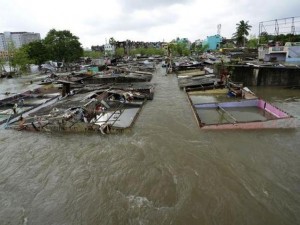Registered with the Registrar of Newspapers for India under R.N.I 53640/91
Vol. XXVI No. 17, December 16-31, 2016
Floods recalled…
by Rochelle Shah
I was enjoying a holiday with my daughter in Mumbai. One night she came into my room and said: “Turn on the TV. Heavy rains in Madras.” Every channel had the same pictures and commentary. But I could not sleep after that. My son and so many of my dearest friends were stranded in Chennai. There was no telephone connectivity, no electricity, no communication. The rivers had burst their banks, the reservoirs were opened, adding to the catastrophe. Sitting in Mumbai, I learned first-hand the meaning of ‘Survivor Guilt’.
I returned on December 10th. People were back on the streets, queuing up waiting patiently for buses, autos, lifts from car and lorry owners. My street – in which I have lived for sixty years – looked sad and forlorn. Water had inundated the ground floor of my house. All around me, our neighbours had also taken a beating but no one had time or inclination to talk about it. Their job was to work together and clear as much debris and get back to a normal routine until the Corporation and MES trained crews came in.

It had happened and, yet again, Chennai had survived.
Deluge, floods – they are not new for Chennai. Off-hand, I recall having been in them many times. In 1966, commuter ship between Madras and the Andamans – m.v. Chidambaram – was battered by the storm and damaged. It was later broken up and sold in lots. Then the Stamatis, a ship bearing the Liberian flag, ran aground on the Marina Beach and became a tourist attraction. It stayed there till 1990.
That same year, my friend and I travelled by car via Pondicherry to Vailankanni Shrine, near Nagapattnam. Heavy rains caught us on the return journey. Along the road we were halted and updated on the situation and the state of the roads. We were able to continue and find our way back only because of the crucial information conveyed by passers-by in an age before cell phones and GPS.
In November 1976 the Tower Block at Nandanam was inundated. Cars floated, the lift shaft was gutted. Our elderly friends were evacuated from the 8th floor by Naval craft. They had to climb out through apartment windows.
November 1990. Friends en route to Singapore were stranded as the airport closed with no further information. They went to Trident Hotel which was over-crowded, but the hotel accommodated them on sofas and make shift beds in the lobby and other available space.
The 2004 Tsunami badly affected most of the East Coast. After three days, the eye of the storm moved south to Nagapattnam and the Vailankanni Shrine situated on the beach. Help came in plenty from agencies such as Caritas, many NGO’s and even film stars.
Back to December 2015. A young man I had worked with, came to see me, and without any drama said: “I was at home with my wife. We were in waist deep water. Suddenly, there was a huge wave. The steel cupboard, with our Ration Card, Aadhar Card, and other important papers) and the TV submerged. (We had not yet paid all the installments on the TV). I grabbed my wife, and swam to high ground. She fractured her arm in this deathly scramble. It has taken us a year of surgery to have it properly set and there is still much pain. We have not got duplicate documents yet.” This was said with no trace of complaint or bitterness – just a stoic recounting of the facts.
A few years before The Flood, a young man had come to our office for a job interview. He was always grinning and said very clearly: “I don’t want a desk job. I won’t sit in the office. I will do all the outdoor work.” (He did not know the word claustrophobia from which he apparently suffered.) He would zoom for work on his motorcycle around the city, happy to be outdoors.
When he came to see me after the floods, I could barely recognise him. He was a ghost of his former happy-go-lucky self. He, his family of two, a few other tenants of their narrow house had to move higher and higher as the water rose alarmingly. Finally, they were confined within a small room built on the roof in the two-storey house. No toilet, no drinking water, no food. It was three days before they were rescued. The trauma was severe. He was treated for more than six months before he started to feel human again. He is still in counseling and on medication. It is not just loss of life, limb and belongings; there is a mental toll too.
Chennaites are low-profile people. When confronted with devastation, they climb to survival without much fanfare. And when stretching out a hand to help another, when opening their homes to homeless strangers, they do not think of caste, creed or status. They do it for their fellow men.

